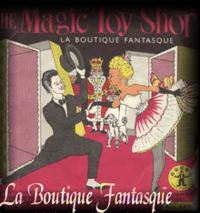
Back La boutique fantasque Spanish La Boutique fantasque French Կախարդական կրպակ Armenian La boutique fantasque Italian 風変わりな店 Japanese Волшебная лавка Russian La Boutique fantasque Swedish
| The Magic Toyshop | |
|---|---|
 Poster for La Boutique fantasque. The can-can dancers are in the foreground with the other characters visible in the background. | |
| Native title | La Boutique fantasque |
| Choreographer | Léonide Massine |
| Music | Ottorino Respighi (based on piano pieces by Gioachino Rossini) |
| Libretto | André Derain |
| Premiere | 5 June 1919 Alhambra Theatre, London, U.K. |
| Original ballet company | Ballets Russes |
| Characters | Shopkeeper Shop Assistant Russian Merchant Tarantella Dancers Queen of Clubs Queen of Hearts The Snob Cossack Chief Dancing Poodles Can-can Dancers |
| Design | André Derain |
| Setting | 1860s France |
| Created for | Enrico Cecchetti Nicolas Zverev Lydia Lopokova Léonide Massine |
La Boutique fantasque, also known as The Magic Toyshop[1] or The Fantastic Toyshop, is a ballet in one act conceived by Léonide Massine, who devised the choreography for a libretto written with the artist André Derain, a pioneer of Fauvism. Derain also designed the décor and costumes for the ballet.[2] Ottorino Respighi wrote the music based on piano pieces by Gioachino Rossini. Its world premiere was at the Alhambra Theatre in London on 5 June 1919, performed by Sergei Diaghilev's Ballets Russes.[3][4]
Massine described how, in Rome for a ballet season, Respighi brought the score of Rossini's Péchés de vieillesse to Diaghilev. The impresario played them to Massine and Respighi. Toulouse-Lautrec was an influence on the period setting and style of La Boutique fantasque, and Massine envisaged the principal character "quite Lautrec-like".[5] Diaghilev arranged for Massine to meet Derain in Paris, and they worked out the scenario with the artist's marionette theatre at his home on the rue Bonaparte. The date of the action was moved from 1832 to the 1860s.[6]
The story of the ballet has similarities to Die Puppenfee ("The Fairy Doll") of Josef Bayer, an old German ballet that had been performed by Jose Mendez in Moscow in 1897 and by Serge and Nicholas Legat in Saint Petersburg in 1903. Others note the similarities to Hans Christian Andersen's The Steadfast Tin Soldier.[7]
Massine's scenario centers on the love story between two can-can dancer dolls in a toyshop,[8] incorporating elements of comedy, national folk dance and mime, as well as classical choreography.
- ^ Richard Taruskin (18 July 2009). Oxford History of Western Music: 5-vol. set: 5-vol. set. Oxford University Press. pp. 1978–. ISBN 978-0-19-981369-8. Retrieved 19 July 2013.
- ^ C. W. Beaumont, "La Boutique Fantasque", in Complete Book of Ballets (New York, 1938; reprint, London, 1951). The 14-page discussion of La Boutique Fantasque gives much information on the first performance, the original setting, and an extended description of the story line.
- ^ Cite error: The named reference
australiadancingwas invoked but never defined (see the help page). - ^ Horst Koegler, The Concise Oxford Dictionary of Ballet, 2nd ed. (Oxford and New York, 1987).
- ^ Drummond, John. Interviews with Massine in: Speaking of Diaghilev. Faber and Faber, London, 1997.
- ^ Buckle R. Diaghilev. London, Weidenfeld and Nicolson Ltd, 1979, p. 353.
- ^ Grace Robert, The Borzoi Book of Ballets (New York, 1946), pp. 66ff.
- ^ boutiquefantasque Archived 18 October 2012 at the Wayback Machine